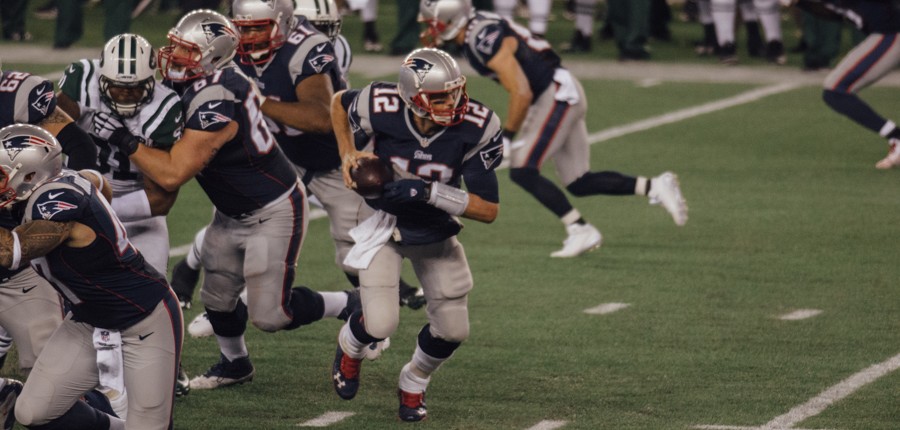Tom Brady, the last of a dying breed
Tom Brady was not a highly touted recruit coming out of high school. He was taken in the sixth round in the 2000 NFL Draft — 199th overall, to be exact. He has faced adversity and has excelled. With a chip on his shoulder, Brady has shredded nearly every defense in his path during his lengthy NFL tenure, becoming one of the best quarterbacks in the history of the game.
Brady overcame a lackluster 40-yard dash time, proving that what he had between the ears was far more valuable than any measurable, such as his bench press or his shuttle run time.
Brady’s rise to primetime has been well documented, and though he continues to be one of the league’s most polarizing players, his competitive edge is truly one-of-a-kind. He has the savvy to give defensive coordinators headaches, the pocket presence to know how to avoid costly turnovers, and perhaps most importantly, he knows how to make the players around him better.
But how many quarterbacks like Tom Brady will we see in the future?
Brady’s counterpart in Super Bowl XLIX, Russell Wilson, is a dynamic runner. In fact, Wilson rushed for 849 yards in the 2014 regular season. That is 26 more rushing yards than Brady has in his entire career. Brady is in his 15th season, while Wilson is in his third. It is a staggering statistic, but it shows how the game is changing, despite the fact that this is an extreme example since Wilson is an absurdly talented runner while Brady is incredibly reluctant to leave to pocket and take off running.
Brady is a menace. But will teams without mobile quarterbacks begin to feel as though dual-threat quarterbacks can thrive in the pros as they watch Wilson torch teams with both his arms and his legs? Running quarterbacks are difficult to defend, but true dual-threat guys can be virtually impossible to stop.
Carolina’s Cam Newton and San Francisco’s Colin Kaepernick are other true dual-threat quarterbacks who readily come to mind, but even Johnny Manziel’s unpredictable playing style caught the attention of pro scouts. The camera was glued to Manziel in the green room on draft day as he “slipped” down the draft board, but he was still a first-round pick (second QB taken, after Blake Bortles, who went to Jacksonville third overall).
There were countless questions about Manziel’s maturity both on-and-off of the playing field, yet he was a first-rounder. At some point leading up to draft day, some kind of serious value was attached to Manziel’s ability to create something out of nothing, a skill that does not always translate to the NFL as well as scouts project.
There is a clear emphasis on— maybe even an infatuation with — mobile quarterbacks in today’s NFL. High-risk, high-reward. Defensive backs are now delivering linebacker-like hits, so even when a quarterback reaches the second level, his health is still in serious question in the open field. Mobile quarterbacks are highlight-reel-producing monsters when they can stay healthy, but that is never a guarantee in such a violent game.
Indianapolis Colts quarterback Andrew Luck is not a runner per se, but he is one heck of an athlete. His 2012 NFL Scouting Combine performance ran circles around Brady’s, quite literally, showing that today’s pocket passers are bigger, stronger, and faster than ever. Luck is mobile, but he is smart too. Great runner. Even better passer.
Similarly, Seattle’s Russell Wilson is a safe open-field runner who opts to slide rather than take massive hits, so it is possible to have the best of both worlds. It should be noted that, like Andrew Luck, Wilson is a phenomenal passer with great touch on his throws, so he is obviously a bit of a statistical outlier because of how outstanding he is at both passing and running.
However, there is something to be said for the pure pocket passer. A handful of premier college programs have stuck with the pocket passer approach, including—but not limited to—USC, Baylor, and Michigan State. Those programs seem to be doing just fine. Pro teams with pocket passers like Peyton Manning and Tom Brady are thriving, too.
So what is all the hype about a QB who looks more like a running back in the open field?
Maybe we will see a pocket passer quarterback renaissance of sorts at some point in time, but it seems highly unlikely with the development of—and success of—today’s up-tempo offenses in both college football and the NFL.
Pocket passers are effective. And while some would argue they have limited upside, it should also be noted that they are less injury-prone. Trade-offs, huh? Yes, they are a very real part of football, especially when it comes to crafting a college program or an NFL franchise with the QB as the integral puzzle piece.
Pocket passers are a joy to watch. But there are fewer and fewer of them, so just in case they become extinct soon, let’s enjoy watching Brady while we can.
Josh Cohen is a freshman majoring in broadcast and digital journalism. His column, “The SCoreboard,” runs Mondays.

